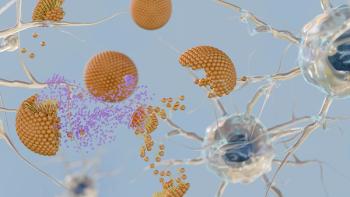
- BioPharm International-04-01-2015
- Volume 28
- Issue 4
Novel Drug Delivery through Use of a Foamed Excipient
Ethylene vinyl acetate (EVA) drug-release technologies are explored.
Formulation challenges are often associated with protein delivery vehicles, and controlled-release strategies that deliver medications locally are believed to offer some advantages. Most biologic formulations are made for a parenteral route of administration, but novel approaches, such as the use of microcellular foams, are being developed to enhance administration profiles and patient compliance. BioPharm International spoke to Jose D. Reyes, global strategic market manager of EVA polymers at Celanese, for clarification about how these foams work and how they would be used to improve the bioavailability of sustained-release biologic formulations with high-protein concentrations.
Excipients as Formulation SolutionsBioPharm: What are some common formulation challenges that arise with biologics?
Reyes: Formulating to prevent aggregation is one challenge. Also, there is big interest in delivering biologics at higher concentrations. Higher concentrations increase the potential for aggregation as more molecules are closer together. Excipients can offer formulation solutions to prevent this. Another problem with use of biologics at higher concentrations is viscosity. As higher concentrations are explored, the viscosity increases, which can lead to painful administration in parenteral delivery such as injections.
BioPharm: How do excipients help stabilize protein formulations?
Reyes: There are many factors that can influence the stability of proteins. Some include: protein concentration, freeze/thaw cycles, salt conditions, pH, temperature, and bacteria. Some types of protein instability are aggregation, oxidation, or conformational. The reason stability is important is that instability can affect activity in the therapeutic effect of a medication and/or could lead to an immune response. Excipients can help stabilize proteins and assist with preserving their therapeutic activity (i.e., efficacy and safety).
Excipients come in various types, such as low-molecular weight, high-molecular weight, liquids, powders, and solids. Today, most proteins are delivered by parenteral administration, which is injection or intravenous infusion. Proteins are in an aqueous solution. Therefore, excipients that are liquids and help prevent aggregation are important. Consideration of a protein’s electrostatic charge plays an important role in how excipients can help with stability.
Proteins in an aqueous solution are in a polar environment because water molecules are polar, owing to the difference in electronegativity between oxygen and hydrogen. Furthermore, proteins themselves can have regions of hydrophobicity and hydrophilicity. By selecting excipients with suitable electrical charges in the microenvironment, excipients can enable water to form hydrogen bonds with a protein. Water molecules on a protein’s surface create a protective zone that prevents water molecules from displacing each other and thereby mitigates proteins from aggregation. Charge consideration of an excipient for an aqueous protein solution, therefore, is important from a design consideration.
Other excipient mechanisms for preventing aggregation--again charge related--may include excipients that are dipolar. A dipolar excipient works by increasing the dielectric constant, weakening electrostatic interactions. Arginine, an amino acid, is an example of a dipolar excipient that is effective at suppressing aggregation. Because of its charge, arginine is also effective for enhancing protein shelf life.
Excipients are also used in combination. For example, excipients such as polysorbates can help prevent denaturing of proteins, and excipients such as human serum albumin help prevent protein adsorption to glass surfaces, which would typically lead to denaturing.
BioPharm: What are the benefits of controlled-release excipients?
Reyes: Controlled release offers enhanced, efficient, and effective drug delivery benefits for patients. Some benefits include: desired drug concentration delivery between effective and toxic levels, reduced side effects, targeting, improved patient compliance, enhanced bioavailability, and cost effectiveness. An example of improved patient compliance may be a situation where a patient needs to visit a clinic or hospital weekly to receive an infusion of a particular drug. Controlled release of the same drug could offer the patient a situation where the drug is delivered at the prescribed concentration for a period of weeks or months via an implant.
Foamed ExcipientsBioPharm: How does the EVA (ethylene vinyl acetate) foam excipient differ from other excipients on the market?
Reyes: Celanese’s EVA foam excipient technology offers the potential to design a microstructure suitable for use in controlled release of low-molecular weight drugs, high-molecular weight drugs such as biologics, stem cells, and/or improve the bioavailability of insoluble drugs such as BCS Class II. The EVA foam excipient is a drug delivery vehicle that could introduce new therapeutic treatment options in the areas of implants, oral, transdermal, and parenteral administrations. EVA is a high-molecular weight polymer excipient that is hydrophobic and can be manufactured to a variety of crystalline or amorphous contents. The percent crystallinity and percent amorphous content not only govern the excipient’s mechanical properties, but also offer ability to alter the polarity of the resin. Through use of super-critical microcellular foaming, in combination with an engineered EVA, one can produce open- or closed-cell foam specifically for a drug’s molecular spatial (conformational) volume, thereby designing unique custom controlled release profiles per drug. The foaming process does not use chemical additives, which could leave residues in the excipient. The patent-pending intellectual property also has a built-in manufacturing technology component for process assurance for real-time quality control of the foam microstructure via online computer tomography; inline instantaneous measured drug concentrations; anti-counterfeiting; and global remote full-process data monitoring.
BioPharm: Why is EVA foam especially relevant for protein-based therapeutics?
Reyes: The EVA foamed excipient, unlike solid polymer excipients, has diffusion pathways (microcellular) engineered to enable large molecules to diffuse in a controlled manner. The EVA foamed excipient is especially relevant for protein-based therapeutics when they are in an aqueous solution. EVA is hydrophobic and will not decompose in the presence of water. Because of this, once a protein therapeutic is seeded into the EVA foamed excipient, one does not need to worry about the foam dissolving and thereby changing the controlled release profile of the excipient’s engineered microstructure. While many consider biodegradable polymer excipients for their delivery vehicles, those materials can have degradation products that are acidic and can alter protein stability. EVA has been used for several years at cryogenic temperatures. EVA is often used for cryogenic stem-cell storage containers including those used in freeze/thaw conditions. In summary, EVA foamed excipient offers a delivery vehicle for controlled-release of large molecules; will not decompose when a protein is in an aqueous solution; has been used in long-term storage via cryogenic temperatures typically used for lyophilized proteins; and has the potential for use in higher-protein concentration solutions for controlled release.
BioPharm: Where is the site of drug delivery in practice?
Reyes: Several drug delivery sites are possible. For example, the EVA foam excipient can be used in the form of an intravaginal ring to deliver drugs. For orthopedic applications, the EVA foamed excipient can be used as an artificial cartilage delivering controlled release of growth factors or stem cells for accelerated healing following knee surgery. This provides a highly localized targeted delivery. The EVA foamed excipient patent pending technology also offers gastroretentive oral dose applications. The EVA foam is seeded with protein therapeutics. There can be one or several foam layers that create the core. Next, a layer is applied to enable a temporary ‘docking’ of the delivery vehicle to a targeted site in the small intestine, for example. An enteric coating provides the capability of moving the EVA foamed excipient through the acidic stomach environment. Docking allows the delivery vehicle to transfer drug contents through cell walls.
BioPharm: Does this foamed excipient have any affect on conformational stability of the biologics?
Reyes: Because of EVA’s ability to vary polarity via comonomer ratios, there is an opportunity to look at charge considerations in the microenvironment in combination with other excipients. More work needs to be done, but the EVA foamed excipient has design levers suitable for investigating conformational stability optimization.
Article DetailsBioPharm International
Vol. 28, No. 4
Pages: 46–47
Citation: When referring to this article, please cite it as R. Hernandez, "Novel Drug Delivery through Use of a Foamed Excipient," BioPharm International28 (4) 2015.
Articles in this issue
over 10 years ago
Modern Manufacturing Systems Key to FDA Quality Initiativeover 10 years ago
Advanced Liquid Particle Counters to Measure Aggregated Proteinsover 10 years ago
Formulating for Needle-free Jet Injectionover 10 years ago
More Evidence that Size Mattersover 10 years ago
Drug Discovery and Development in Indiaover 10 years ago
Core-Shell Phase Column Increases Reproducibilityover 10 years ago
IV Bag Filling and Closing System Eliminates ContaminationNewsletter
Stay at the forefront of biopharmaceutical innovation—subscribe to BioPharm International for expert insights on drug development, manufacturing, compliance, and more.




